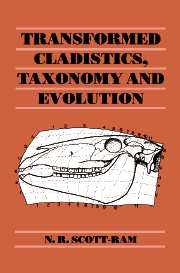Book contents
- Frontmatter
- Contents
- Preface
- Introduction
- PART I ISSUES PERTAINING TO THE PHILOSOPHY OF SCIENCE
- PART II THE STATUS OF THEORETICAL CLASSIFICATIONS
- 2 Evolutionary systematics and theoretical information
- 3 Phylogenetic cladistics and theoretical information
- PART III THE STATUS OF DESCRIPTIVE CLASSIFICATIONS
- Notes
- Bibliography
- Author index
- Subject index
3 - Phylogenetic cladistics and theoretical information
Published online by Cambridge University Press: 21 October 2009
- Frontmatter
- Contents
- Preface
- Introduction
- PART I ISSUES PERTAINING TO THE PHILOSOPHY OF SCIENCE
- PART II THE STATUS OF THEORETICAL CLASSIFICATIONS
- 2 Evolutionary systematics and theoretical information
- 3 Phylogenetic cladistics and theoretical information
- PART III THE STATUS OF DESCRIPTIVE CLASSIFICATIONS
- Notes
- Bibliography
- Author index
- Subject index
Summary
Since the publication of Hennig's Phylogenetic Cladistics in 1966, cladistics has undergone many changes such that a diversity of approaches can be made out in the literature. In this section I want to concentrate on the present–day views of phylogenetic cladists such as Cracraft, Eldredge and Wiley. At the same time I will outline the basic views of Hennig, so that the emphasis is on what the latter-day phylogenetic cladists draw from Hennig, and on how they modify it. In this way we will be better prepared to examine the move to transformed cladistics.
For the most part it is assumed that cladistics arose with Hennig – the two are seen to be synonymous. However, this is not strictly true because many evolutionary taxonomists before the arrival of Hennigian cladistics, had decidedly cladistic attitudes. Indeed the discussion of ‘horizontal’ and ‘vertical’ classifications anticipated some of the issues raised by Hennig's cladism, and such discussions had their roots in the issues over cladism or gradism. For example, the Swedish school of paleontologists, headed by Stensiö, Jarvik and Säve-Söderbergh had strong cladistic leanings. Furthermore, there is some evidence that the Italian zoologist Daniele Rosa (1857–1944) invented, or at least anticipated, cladistics. Historically speaking, then, Hennig did not invent cladistics. It had been independently anticipated by at least two sources. However, Hennig's contribution is still substantial and his originality stems from an attempt to detect patterns in present-day organisms.
Hennig's strict belief in evolution is clearly reflected in his aims.
- Type
- Chapter
- Information
- Transformed Cladistics, Taxonomy and Evolution , pp. 66 - 102Publisher: Cambridge University PressPrint publication year: 1990



